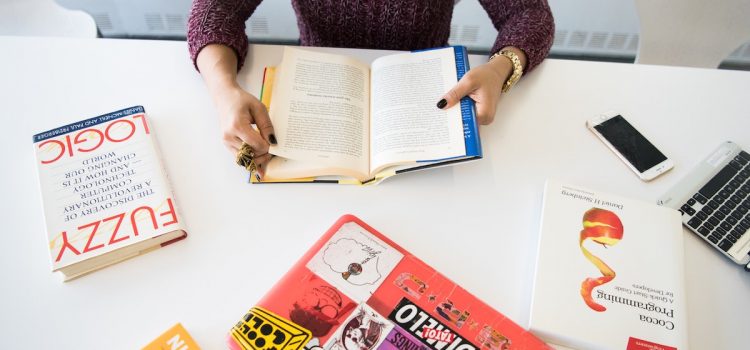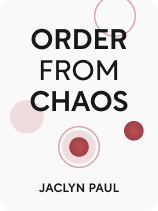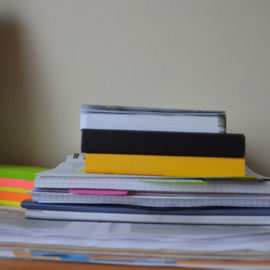

This article is an excerpt from the Shortform book guide to "Order From Chaos" by Jaclyn Paul. Shortform has the world's best summaries and analyses of books you should be reading.
Like this article? Sign up for a free trial here.
How does ADHD affect one’s life? How can ADHDers take back control of their lives?
If you have ADHD, you may feel like your life is one big mess. In Order From Chaos, Jaclyn Paul shows you that you’re not alone, as most people with ADHD suffer from organizational issues.
Read below for a brief Order From Chaos book overview.
Order From Chaos by Jaclyn Paul
In the Order From Chaos book, Jaclyn Paul argues that people with ADHD face organizational challenges that can make their lives feel chaotic and frustrating. By implementing Paul’s strategies and systems, though, ADHDers can gain control over their lives and find greater peace. The process of getting organized starts with learning about yourself and how your brain works, and then using this understanding to identify your unique needs and preferences. After that, you can take concrete steps toward improving your organization by finding ways to contain your current mess and then finding the right system for managing any new task or project that comes into your life.
Paul is a best-selling author and blogger with ADHD. She has written for such publications as ADHD Roller Coaster and Houston Family Magazine. She’s also published the novel She’s Not Home under the pen name Lena George.
What Is ADHD and How Does It Affect Functioning?
ADHD (attention deficit hyperactivity disorder) is a neurobiological condition that impairs working memory and executive function, among other things. Working memory is the capacity to hold information in our brains for immediate use in the short term, such as remembering what you need to retrieve when you walk into another room. Executive functioning refers to a set of skills related to planning ahead and making decisions. Everyone struggles with working memory and executive function from time to time, but for people with ADHD, these deficits occur at a severity and frequency that substantially interferes with their daily lives.
According to Paul, ADHD can cause you to be constantly distracted by both your own thoughts and your environment. It can also cause you to make impulsive decisions, struggle to stop a task once you’ve begun it, and have difficulty conforming to common organizational methods. These and other traits can make you disorganized, and being disorganized can then make your symptoms worse, creating a negative cycle.
What’s more, ADHD can have negative impacts on your personal, professional, and social life. People often view ADHDers as lazy and irresponsible, but their behavior is the result of actual differences in their brains, not the result of a character flaw, explains Paul. These differences make certain aspects of life that are easy for most people nearly impossible for ADHDers.
As you work to get more organized, it’s important to avoid judging yourself for the things you struggle with, any more than you would with a physical ailment. Just like you wouldn’t judge a person with epilepsy for taking medication or needing to avoid flashing lights, you shouldn’t judge yourself or other ADHDers for the way their atypical brains affect them.
Before You Begin: Get Your Symptoms Under Control
According to Paul, the first thing you must do to get organized is to get your ADHD symptoms under control so that you can begin the work of managing the ways in which ADHD affects your life. No matter how strong your organizational system is, it won’t do you any good if your symptoms are so severe that you can’t follow it. For some people, this involves getting on stimulant medication to reduce the severity of their symptoms. Medication will not make your symptoms go away, nor will it make your life easy, but it can help mitigate your symptoms and make your life more manageable. Paul explains that less than a tenth of ADHDers who try stimulant medication are unable to benefit from any of them.
Step 1: Getting to Know Yourself
Every person with ADHD is different, and their ADHD affects them differently. There’s no cookie-cutter method for organization that will work perfectly for everyone, so you have to form an understanding of how your ADHD affects you personally in order to devise the best organizational system to manage it.
Understand Your Purpose
An essential part of Paul’s recommendations for better organization is to identify the reason you want to get organized and keep that front of mind as you begin implementing her tips. Staying motivated is particularly difficult for people with ADHD, so you’ll need to have a purpose for organizing that you can come back to any time it starts to feel too difficult. This purpose should be unique to you and related to the values that are important to you. It also can’t stem from the belief that you should be able to do something. That comes from a place of judgment and external pressure, and your purpose needs to provide you with internal motivation. Your purpose should help you nurture your genuine self so you can live the life you want to live.
For example, you may want to get organized because you value time with your friends and family, and better organization would give you more time to enjoy their company. You may value the serenity of an uncluttered workspace, or the freedom to take time off from work when you need it without feeling like you’re falling behind.
Understand Your Limitations
Another part of getting to know yourself is understanding your capabilities and limitations. Organizing becomes much easier when you only have to organize a manageable number of items. This means you need to be able to say no to people and commitments, let go of things in your life that don’t serve your purpose, and only use as much physical space and belongings as you can reasonably manage.
Paul explains that ADHD brains have less dopamine—the neurotransmitter that drives the body’s reward system—available to them. This means ADHDers seek stimulation and novelty, which can lead them to take on more obligations and commitments than they can handle. While it may be frustrating to accept, sometimes you need to demand less of yourself so you can consistently meet expectations. You may simply have a lower threshold for what you can reasonably take on than someone without ADHD.
Understand How You Learn
According to Paul, understanding your learning style will help you on your journey to better organization. Getting organized is a process of teaching yourself new habits, so it’s important to understand the best way to accommodate your learning needs. Paul describes three types of learning styles: auditory, visual, and tactile.
- Auditory learners learn best from hearing information. They may read out loud rather than silently, and they often benefit from discussing information with others in order to better comprehend it.
- Visual learners learn best by seeing. They benefit from pictures and graphics, and they’re good at visualizing, so they’re especially engaged by imagery in stories. Visual learners are particularly prone to the pitfall of “out of sight, out of mind,” which means that once something is no longer in their sight, they forget about it.
- Tactile learners learn best by doing. They benefit from activities like building and drawing, and they may be particularly expressive with their hands and bodies. They may struggle to sit still and focus for long periods without something physical to do.
Your learning style will affect what organizational system works best for you, explains Paul. If you’re a visual learner, you may respond well to a system that incorporates color and sequence (like file folders with the tabs arranged sequentially) to help you keep track of different things. If you’re an auditory learner, you may do your best organizing with a podcast or music playing in the background. If you’re a tactile learner, you’ll need to pause from your organizing now and then to move your body around. You likely have a combination of preferred learning styles, with one or two being dominant. You can use online quizzes to identify your learning styles and then tailor your organizational system to suit your learning style.
Understand Your Scheduling Needs
Finally, identify your ideal daily schedule based on your energy and focus levels, writes Paul. Do you function best if you go to bed early and get up early, or are you more productive if you stay up later and sleep in? What types of work are easiest for you to complete at various times in the day? You may want to reserve your physical organization tasks for the time of day when you have the most energy, and do the ones that require little thought for the time of day when you may have less mental energy.
Once you’ve identified your purpose, limitations, learning style, and ideal schedule, you can begin the work of containing your current mess.
Step 2: Contain Your Current Mess
According to Paul, if you’re already behind on your organization, you won’t be able to jump right into a new system. You need to get a handle on your current state of disorganization first. ADHDers can become disorganized more easily because they tend to quickly be overwhelmed by new input, and we’re all constantly receiving various types of input: Much of it is informational like ideas and obligations, and much of it is physical like mail and belongings. For ADHDers, the overwhelm from all this input often leads to piles.
Piles accumulate when we have no system for dealing with incoming stuff. We get a piece of mail or find a dirty sock on the floor and put it in a pile for us to deal with later, which grows and grows until it feels too big to manage. These piles feel necessary—particularly for those who suffer from “out of sight, out of mind” tendencies—so that we don’t lose track of important items, but ultimately these things tend to get lost in the piles anyway.
Organizing piles starts with containing them, which means designating a specific location to keep those items until you’re ready to deal with them.
Containing Physical Items
To contain physical items that you struggle to keep organized, Paul recommends using baskets. While it may seem similar to a pile, a basket provides physical boundaries for a pile, which will help keep it more manageable. Each basket should only contain one type of item. That way, as soon as you find an item that needs to be stored, you know exactly where to put it, and you know exactly where to look for it the next time you need it.
Also, remember your learning style (and those of any ADHDers with whom you may share your space): If you know you have “out of sight, out of mind” tendencies, putting items in a place where you can’t see them won’t be sustainable. If you don’t use the items frequently, you’ll forget about them. If you do use them frequently, you’ll never be able to keep up with a system that hides them from your sight because you’ll inevitably start leaving them outside of their container due to your need to keep visual track of them. To beat your “out of sight, out of mind” tendencies, use open containers that will help you use those items as visual reminders without them being strewn all over the place.
Containing Email and Calendar Reminders
You may also have different “piles,” such as thousands of unread emails, mountains of written reminders, or digital calendars filled with things you may or may not do. These are also things that need to be contained, insists Paul.
To better contain your emails and calendar reminders, be ruthless about what you keep and what you don’t. If you have what feels like an overwhelming amount of unread emails, consider deleting all emails received before a certain date to clear out the current clutter. Then downsize: Unsubscribe from any newsletters, promotional emails, or other things you don’t use. Similarly, with your calendar, only include items that have to be done and are time sensitive. Filling your calendar with things you may or may not do is a recipe for an abandoned calendar.
Thought Containers
ADHDers also have trouble remembering things without concrete reminders. Rather than assuming you’ll remember something, Paul recommends creating thought containers by finding a way to record your thoughts immediately, before they can slip out of your mind, and storing those thoughts in a way that will make them easy to access later. This might mean keeping a dry-erase board in every room of your house or always having a pad of sticky notes on hand that you then store in a physical container.
This can also be helpful when other people need to ask you to do something. If your child needs a permission slip signed, or your coworker needs you to take the lead on a new project, they can put a note into your thought container to ensure you attend to it.
Step 3: Implement an Organizational System
Once you’ve got your current situation contained, you can implement a system for managing your incoming items, tasks, and projects. The most important part of establishing a system for organization is to find one that works for you. It should be both simple and sustainable, meaning it should require as little work from you as possible and should be something you can reasonably do every week in perpetuity.
Paul doesn’t explicitly describe many organizational systems, but she highly recommends reading David Allen’s Getting Things Done and using his tips to design your own system.
Funneling Containers Into Inboxes
All of the containers you created in Step 2 represent a source of incoming tasks that require you to act on them. Paul suggests funneling these different incoming sources into as few inboxes as possible to make it easier to process them. For example, instead of having separate inboxes for your voicemails, your physical mail, and your emails, you might print out your emails and voicemails and consolidate them into one “communication” inbox. Paul recommends using as many containers as you need, but then putting those items into as few inboxes as you can get by with. This way, when it comes time to sort through those inboxes, you only have a few to manage, which, as we’ll discuss next, is the next step in organizing.
Managing Tasks
Each item that goes into one of your inboxes is a potential task, and you need to sort through these regularly to keep them from overwhelming you. To empty an inbox, it’s important to take out one item at a time and to not put anything back in after you’ve taken it out. Then assess that item and decide if it’s something you can take care of in less than five minutes (or less than two if you know that a five-minute task will distract you too much from your management process). If it’s a short task, complete it immediately. If it’s a larger task, it needs to be logged in your project management system, which we’ll discuss next.
Managing Projects
Paul explains that a task is an individual, discrete activity that has to be done to accomplish something. A project is anything that requires two or more tasks to complete. As you come across potential projects while emptying your inboxes, it’s highly tempting to drop what you’re doing and immediately start working on these larger activities. However, this will derail your organizational system and result in an overflowing inbox because you’ll be too distracted to tend to it. Instead of starting them immediately, you need to establish a way to record such projects so you can come back to them later.
Paul uses an app to keep track of her projects, and there are many such apps available. You can also use a paper system if that works better for you. Whatever system you choose should allow you to record projects and then break them down into smaller tasks, and it should allow you to note whether you can complete these tasks now or if they’re dependent on something else (like if they can only be done after another task is completed, or you’re waiting on someone else to do something so you can complete the task).
Keeping a To-do List
To keep track of the very next tasks you need to complete for your various projects, you can keep a to-do list. A to-do list is not for projects; it’s only for specific, single tasks that don’t require any preceding steps to be completed first. Something like “renew vehicle registration” may seem like a simple task, but it’s actually a project that requires several tasks, such as making an appointment to have your car inspected, then submitting the renewal application, and later applying those little stickers to your vehicle’s license plate.
So activities like “renew vehicle registration” shouldn’t go on your to-do list, but instead in your project management system, and the next task required to make progress on that project (like “make appointment to get car inspected”) should go on the to-do list.
Keeping Track of Future Projects
Paul also recommends keeping a list of things you’d like to do if you ever get the time but don’t want to act on currently. ADHDers have a lot of ideas, and they often have difficulty prioritizing them. It’s easy to get so excited about a project you can’t currently accomplish that you end up neglecting the things you need to do now. Recording these future projects and ideas gives you the relief of not having to keep up with them mentally, and also the freedom to say, “I’m not going to work on this right now, but maybe I will someday.”

———End of Preview———
Like what you just read? Read the rest of the world's best book summary and analysis of Jaclyn Paul's "Order From Chaos" at Shortform.
Here's what you'll find in our full Order From Chaos summary:
- What ADHD is and how it affects cognitive functioning
- How those with ADHD can gain control over their lives and find peace
- How to implement an organization system that works with your needs






